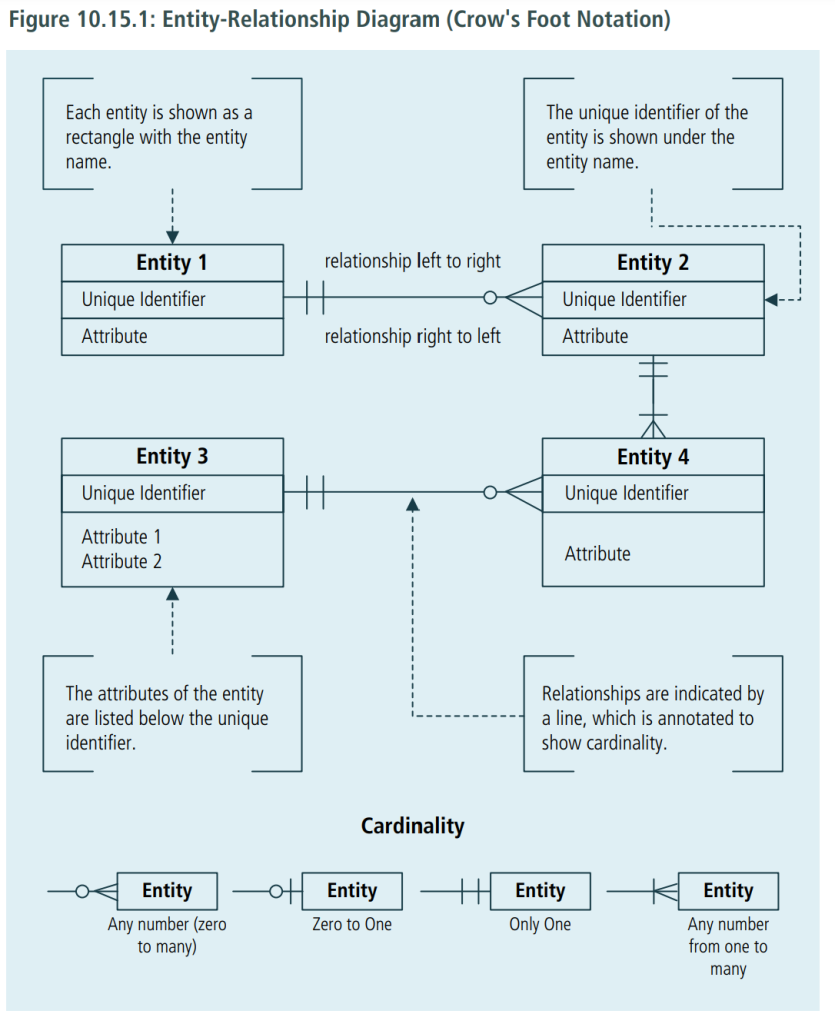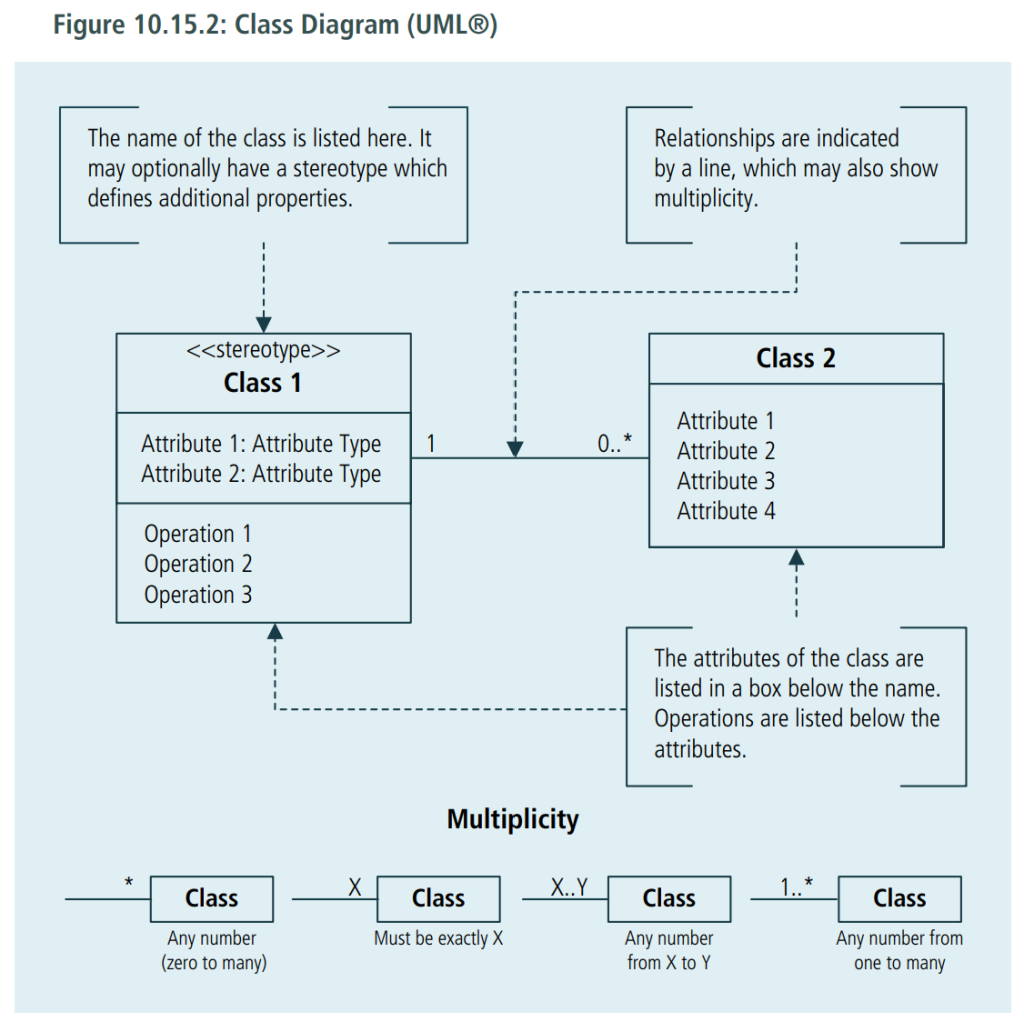10.15.1 Purpose
A data model describes the entities, classes or data objects relevant to a domain, the attributes that are used to describe them, and the relationships among them to provide a common set of semantics for analysis and implementation.
10.15.2 Description
A data model usually takes the form of a diagram that is supported by textual descriptions. It visually represents the elements that are important to the business (for example, people, places, things, and business transactions), the attributes associated with those elements, and the significant relationships among them.
Data models are frequently used in elicitation and requirements analysis and design, as well as to support implementation and continuous improvement.
There are several variations of data models:
- Conceptual data model: is independent of any solution or technology and can be used to represent how the business perceives its information. It can be used to help establish a consistent vocabulary describing business information and the relationships within that information.
- Logical data model: is an abstraction of the conceptual data model that incorporates rules of normalization to formally manage the integrity of the data and relationships. It is associated with the design of a solution.
- Physical data model: is used by implementation subject matter experts to describe how a database is physically organized. It addresses concerns like performance, concurrency, and security.
The conceptual, logical, and physical data models are developed for different purposes and may be significantly different even when depicting the same domain.
At the conceptual level, different data modelling notations are likely to produce broadly similar results and can be thought of as a single technique (as presented here). Logical and physical data models include elements specific to the solutions they support, and are generally developed by stakeholders with expertise in
implementing particular technical solutions. For instance, logical and physical entity-relationship diagrams (ERDs) would be used to implement a relational database, whereas a logical or physical class diagram would be used to support object-oriented software development.
Object diagrams can be used to illustrate particular instances of entities from a data model. They can include actual sample values for the attributes, making object diagrams more concrete and more easily understood.
10.15.3 Elements
.1 Entity or Class
In a data model, the organization keeps data on entities (or classes or data objects). An entity may represent something physical (such as a Warehouse), something organizational (such as a Sales Area), something abstract (such as a Product Line), or an event (such as an Appointment). An entity contains attributes and has relationships to other entities in the model.
In a class diagram, entities are referred to as classes. Like an entity in a data model, a class contains attributes and has relationships with other classes. A class also contains operations or functions that describe what can be done with the class, such as generating an invoice or opening a bank account.
Each instance of an entity or class will have a unique identifier that sets it apart from other instances.
.2 Attribute
An attribute defines a particular piece of information associated with an entity, including how much information can be captured in it, its allowable values, and the type of information it represents. Attributes can be described in a data dictionary (see Data Dictionary (p. 247)). Allowable values may be specified through business rules (see Business Rules Analysis (p. 240)).
Attributes can include such values as:
- Name: a unique name for the attribute. Other names used by stakeholders may be captured as aliases.
- Values/Meanings: a list of acceptable values for the attribute. This may be expressed as an enumerated list or as a description of allowed formats for the data (including information such as the number of characters). If the values are abbreviated this will include an explanation of the meaning.
- Description: the definition of the attribute in the context of the solution.
.3 Relationship or Association
The relationships between entities provide structure for the data model, specifically indicating which entities relate to which others and how.
Specifications for a relationship typically indicate the number of minimum and maximum occurrences allowed on each side of that relationship (for example, every customer is related to exactly one sales area, while a sales area may be related to zero, one, or many customers). The term cardinality is used to refer to the minimum and maximum number of occurrences to which an entity may be related. Typical cardinality values are zero, one, and many.
The relationship between two entities may be read in either direction, using this format:
Each occurrence (of this entity) is related to (minimum, maximum) (of this other entity).
In a class model, the term association is used instead of relationship and multiplicity is used instead of cardinality.
.4 Diagrams
Both data models and class models may have one or more diagrams that show entities, attributes, and relationships.
The diagram in a data model is called an entity-relationship diagram (ERD). In a class model, the diagram is called a class diagram.


.5 Metadata
A data model optionally contains metadata describing what the entities represent, when and why they were created or changed, how they should be used, how often they are used, when, and by whom. There could be restrictions on their creation or use, as well as security, privacy, and audit constraints on specific entities or whole groups of entities.
10.15.4 Usage Considerations
.1 Strengths
- Can be used to define and communicate a consistent vocabulary used by domain subject matter experts and implementation subject matter experts.
- Review of a logical data model helps to ensure that the logical design of persistent data correctly represents the business need.
- Provides a consistent approach to analyzing and documenting data and its relationships
- Offers the flexibility of different levels of detail, which provides just enough information for the respective audience.
- Formal modelling of the information held by the business may expose new requirements as inconsistencies are identified.
.2 Limitations
- Following data modelling standards too rigorously may lead to models that are unfamiliar to people without a background in IT.
- May extend across multiple functional areas of the organization, and so beyond the business knowledge base of individual stakeholders.
